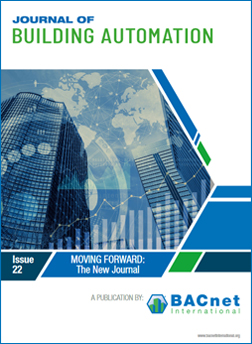Control Network Newsletter

BAS Integration: The Reality of a Multi-Protocol World
 The BACnet International Journal is now the Journal of Building Automation, published by BACnet International. The Journal will continue to report on BACnet developments and applications but will also cover building automation topics and the role of BACnet in the industry as the open, interoperable integration platform for intelligent buildings. According to Andy McMillan president and managing director at BACnet International, "As BACnet has evolved and expanded to become the global standard for building automation, it's time for the Journal's focus to evolve and expand as well."
The BACnet International Journal is now the Journal of Building Automation, published by BACnet International. The Journal will continue to report on BACnet developments and applications but will also cover building automation topics and the role of BACnet in the industry as the open, interoperable integration platform for intelligent buildings. According to Andy McMillan president and managing director at BACnet International, "As BACnet has evolved and expanded to become the global standard for building automation, it's time for the Journal's focus to evolve and expand as well."
Harpartap Parmar, senior product manager at Contemporary Controls, shared his insights for the December issue of the Journal in the article, "BAS Integration: The Reality of a Multi-Protocol World."
Please find an excerpt below:
The Building Automation industry has seen migration from vendor-specific proprietary protocols towards BACnet which has provided tremendous benefits and choice to building owners and systems installers. BACnet provides the unifying protocol and universal access for operator workstations and global controllers and any value-added application that follows the BACnet standard. This includes being able to incorporate legacy, proprietary Building Automation Systems (BAS) into BACnet as well as newer non-BACnet technologies into this common ecosystem.
BACnet Integration using Routers and Gateways
A gateway can translate one protocol to another, and there are multiple protocol gateways available for integration to BACnet. The use of routers and gateways has enhanced the life of legacy BAS installations. With the use of gateways, replacement devices can be based on the new BACnet standard and can co-exist with the existing legacy devices, preventing a full-scale replacement. Modbus is another popular protocol traditionally used in the energy industry that lends itself well for BMS integration with the use of a gateway. EnOcean is another protocol that provides options for easy installation with its wireless energy-harvesting technology. This can be useful for cleanroom, retrofit or remote installations. Again, a gateway can provide the interconnect for EnOcean devices to BACnet and vice-versa.
BACnet Integration using Physical Inputs/Outputs
Systems with unused I/O or the ability to add I/O can utilize BACnet remote I/O as a gateway to BACnet. This allows equipment manufacturers who do not yet have BACnet support to offer BACnet integration to their customers. Similarly, a BACnet controller can be used as remote I/O which provides the added advantage of data conversion.
BACnet, Cloud and IoT-based Systems
Cloud and IoT-based systems can be implemented into a hybrid system. BACnet can operate over different physical layers—over wired Ethernet or Wi-Fi as well as EIA-485 with BACnet MS/TP. BACnet provides the unifying connectivity and local control while the IoT and cloud provide options to analyze the data for optimization for greener energy efficient buildings. This approach is evident with the addition of an IoT protocol like MQTT and cloud connectors in traditional BACnet devices.
BACnet Community and Associations
BACnet now supports all aspects of a building including HVAC, access control, elevators and lighting. Organizations, such as ASHRAE, BACnet International and BIG-EU provide support and education on the latest BACnet protocol and devices. The BTL Certification program confirms that the devices will work in the field. The BACnet Institute, as well as webinars and articles in the publications offer information about new products and best-in-class installations and trends. With these resources and advantages, BACnet will continue to be the protocol of choice for the building automation industry.
Click here to read the complete article on page 6 of the Journal of Building Automation (PDF).